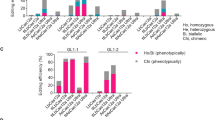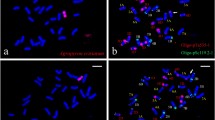Summary
The c2 locus of Zea mays, identified as one of the genes affecting anthocyanin biosynthesis, was cloned using the transposable element En (Spm) as a gene tag. The Spm element present at the c2 locus in the autonomously mutating c2-m1 line was isolated using En1 element specific probes. Sequences flanking the element were identified as c2 locus specific and were used to clone the nonautonomous c2-m2 and wild-type alleles. The cloning and analysis of a cDNA complementary to the c2 locus provided evidence that this gene encodes the enzyme chalcone synthase.
Similar content being viewed by others
References
Benton WD, Davis RW (1977) Screening λgt recombinant clones by hybridization to single plaques in situ. Science 196:180–182
Bingham PM, Levis R, Rubin GM (1981) Cloning of DNA sequences from the white locus of D. melanogaster by a novel and general method. Cell 25:693–704
Bonas U, Sommer H, Harrison BJ, Saedler H (1984) The transposable element Tam1 of Antirrhinum majus is 17 kb long. Mol Gen Genet 194:138–143
Brink RA, Greenblatt IM (1954) Diffuse, a pattern gene in Zea mays. J Hered 45:47–50
Coe EH Jr (1957) Anthocyanin synthesis in maize. A gene sequence construction. Am Nat 91:381–385
Coe EH Jr, Neuffer MG (1977) The genetics of corn. In: Sprague GF (ed) Corn and corn improvement. American Society of Agronomy Inc, Madison, Wisconsin, pp 111–223
Davis RW, Hyman RW (1971) A study in evolution: The DNA base sequence homology between coliphages T7 and T3. J Mol Biol 62:287–301
Davis RW, Simon M, Davidson N (1971) Electron microscope heteroduplex methods for mapping regions of base sequence homology in nucleic acids. Methods Enzymol 21:413–428
Dooner HK (1983) Coordinate genetic regulation of flavanoid biosynthetic enzymes in maize. Mol Gen Genet 189:136–141
Dooner HK, Nelson OE (1979) Interaction among C, R and Vp in the control of the Bz glucosyltransferase during endosperm development in maize. Genetics 91:309–315
Fedoroff N (1983) Comparison of host strains for cloning maize DNA into bacteriophage lambda. Plant Mol Biol Reporter 1:27–29
Fedoroff N, Furtek DB, Nelson OE Jr (1984) Cloning of the bronze locus in maize by a simple and generalizable procedure using the transposable controlling element Activator (Ac). Proc Natl Acad Sci USA 81:3825–3829
Frischauf AM, Lehrach H, Poutska A, Murray N (1983) Lambda replacement vectors carrying polylinker sequences. J Mol Biol 170:827–842
Karn J, Brenner S, Barnett L, Cesareni G (1980) Novel bacteriophage cloning vector. Proc Natl Acad Sci USA 77:5172–5176
Maniatis T, Fritsch EF, Sambrook J (1982) Molecular cloning: a laboratory manual. Cold Spring Harbor Laboratory, Cold Spring Harbor, New York
Martin C, Carpenter R, Sommer H, Saedler H, Coen ES (1985) Molecular analysis of instability in flower pigmentation of Antirrhinum majus following isolation of the pallida locus by transposon tagging. EMBO J 4:1625–1630
McClintock B (1964) Aspects of gene regulation in maize. Carnegie Inst Year Book 63:592–602
McClintock B (1967) Regulation of pattern of gene expression by controlling elements in maize. Carnegie Inst Year Book 65:568–578
McCormick S, Coe EH (1977) Gene action sequence and regulation of anthocyanin biosynthesis in corn: In vivo complementation. Genetics 86:42 (abstract)
McCormick S (1978) Pigment synthesis in maize aleurone from precursor fed to anthocyanin mutants. Biochem Genet 16:777–785
O'Reilly C, Shepherd NS, Pereira A, Schwarz-Sommer Zs, Bertram I, Robertson DS, Peterson PA, Saedler H (1985) Molecular cloning of the a1 locus of Zea mays using the transposable elements En and Mul. EMBO J 4:877–882
Paz-Ares J, Wienand U, Peterson PA, Saedler H (1986) Molecular cloning of the c locus of Zea mays: a locus regulating the anthocyanin pathway. EMBO J, in press
Pereira A, Schwarz-Sommer Zs, Gierl A, Bertram I, Peterson PA, Saedler H (1985) Genetic and molecular analysis of the Enhancer (En) transposable element system of Zea mays. EMBO J 4:17–23
Peterson PA (1965) A relationship between the Spm and En control system in maize. Am Nat 99:391–398
Peterson PA (1983) Newly originated mutable alleles of the c2 locus. Maize Gen Coop News Lett 58:3
Peterson PA (1984) Autonomous mutable c2-m3. Maize Gen Coop NewsLett 84:3
Reddy AR, Peterson PA (1977) Controlling element alleles in the analysis of the genetic control of the anthocyanin pathway in maize. Can J Genet Cytol 19:111–117
Reddy GM, Coe EH Jr (1962) Inter-tissue specific complementation: A simple technique for direct analysis of gene-action sequence. Science 138:149
Reif HJ, Niesbach U, Deumling B, Saedler H (1985) Cloning and analysis of two genes for chalcone synthase from Petunia hybrida. Mol Gen Genet 199:208–215
Reimold U, Kröger M, Kreuzaler F, Hahlbrock K (1983) Coding and 3′non-coding nucleotide sequence of chalcone synthase mRNA and assignment of amino acid sequence of the enzyme. EMBO J 2:1801–1805
Schwarz-Sommer Zs, Gierl A, Cuypers H, Peterson PA, Saedler H (1985) Plant transposable elements generate the DNA sequence diversity needed in evolution. EMBO J 4:591–597
Schwarz-Sommer Zs, Gierl A, Klösgen RB, Wienand U, Peterson PA, Saedler H (1984) The Spm (En) transposable element controls the excision of a 2-kb DNA insert at the wx-m8 allele of Zea mays. EMBO J 3:1021–1028
Sommer H, Saedler H (1986) Structure of the chalcone synthase gene of Antirrhinum majus. Mol Gen Genet, 202:429–434
Styles DE, Ceska O (1977) The genetic control of flavanoid synthesis in maize. Can J Genet Cytol 19:289–302
Wienand U, Sommer H, Schwarz Zs, Shepherd N, Saedler H, Kreuzaler F, Ragg H, Fautz E, Hahlbrock K, Harrison B, Peterson PA (1982) A general method to identify plant structural genes among genomic DNA clones using transposable element induced mutations. Mol Gen Genet 187:195–201
Author information
Authors and Affiliations
Additional information
Communicated by P. Starlinger
Rights and permissions
About this article
Cite this article
Wienand, U., Weydemann, U., Niesbach-Klösgen, U. et al. Molecular cloning of the c2 locus of Zea mays, the gene coding for chalcone synthase. Molec Gen Genet 203, 202–207 (1986). https://doi.org/10.1007/BF00333955
Received:
Issue Date:
DOI: https://doi.org/10.1007/BF00333955




